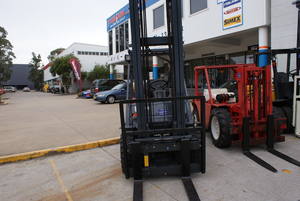 Australia's used forklift market has seen prices flatten due to excess stock levels. |
The Australian market for used forklifts has been in the doldrums following a spate of liquidations, due to the global financial crisis (GFC), which saw used equipment flood the market.
That, coupled with government incentives to boost new equipment sales, has driven down prices.
Forkliftaction.com News asked some local players whether the market is starting to recover.
Not according to Brian Talbot, of Starline Forklifts. He says there is still too much old stock available. However, he has seen the market for used rough terrain forklifts improving.
Damien Garvey, national sales manager for NTP Forklifts Australia, agrees. "At this stage, and until surplus stock levels reduce, [the market] will remain down.
"There are still a lot of unreserved auctions and surplus equipment available on the market at below market value."
He says despite the downturn, warehouse equipment, such as battery electric forklifts, has been steadily growing against the IC market.
Garvey says government incentives did not result in a flood of forklift trade-ins. "A lot of companies may have purchased additional equipment for their fleet or held onto old units as spares.
"Generally in a downturn all equipment sales are affected, both new and used. The service, parts and rental business generally improve as customers keep older machines alive or rent short term to address extra equipment needs."
Dealers say the profile of second-hand forklift buyers remains the same; they just get scarcer in a downturn. Second-hand buyers are typically self employed or in small businesses where they use only one or two units.
Ross Grassick, of Lencrow Group, says prices for new and used equipment have flattened as most people bought new by last December. He, too, has seen an increase in rough terrain units over the past few months.
According to Grassick, one main problem in the Australian second-hand forklift market is there is no redundancy policy for forklifts. "In access equipment, units have a 10-year life before the certification cost makes them non-commercial. In the forklift industry we still have 45-year-old units in operation."
He says Australia needs to ensure units have a fixed working life and then go to scrap. "This way the quality and safety of used units will be maintained."
The tide is turningBut it's not bleak news for everyone. John Flinn, of Hystandard Handling Equipment, says the company's used forklift sales are up 338% year on year, with sales across all models.
"The increase in trades from government incentives allowed us to focus on used equipment and achieve the increase in used sales activity.
"We give realistic values for trade-in equipment, which enables us to turn over used equipment quickly.
"Realistic valuations on used equipment are critical to avoid the large stockpiles some other dealers seem to have."
To survive the GFC, Flinn says the company focused on looking after existing customers and taking a positive approach to their desired business outcomes.
On the future for the used equipment market, Flinn is optimistic. "If a company is sensible about depreciation on fleet trucks and pays fair wholesale value for trade-in equipment, the future is good.
"If you have a situation where a company inflates trade-in values to win new truck business or does not take a conservative position on fleet trucks, it's just a matter of time before they have serious problems."
George Pappas, national used truck and dealer manager for Linde Material Handling, tells
Forkliftaction.com News that, despite a difficult start to the year, recent demand for used trucks has been strong across all states and the market has definitely turned.
However, he says there are still repercussions from liquidations taking place and the continued effects of the extremely poor results achieved by most on-line and some physical auction houses.
He says the company's 1.8 ton to 3.5 ton counterbalance trucks are performing well, while there has been an unexpected increase in the market of buyers taking up well-priced reach and warehouse trucks.
"The market for Linde heavy trucks has continued to be buoyant; we still can't keep up with demand in this sector," he says.
On the future, Pappas sees improvements in the market but is cautious about expecting any great changes. "Customers are expecting more from suppliers. They see the benefits of buying direct from manufacturers as becoming even more valuable as long as we can continue to offer value.
"The risks in the auction market for both buyer and seller will be crystallised over the next year but it will continue to offer a valuable channel for disposing of excess stock."
Cliff Chadwick, of Chadwick Forklifts, says he took a conservative approach during the GFC. "I was very careful with my purchases. I didn't offer as much and I avoided slow-moving stock."
He is optimistic about the used market's future. "Auctions have slowed, OEMs have stopped dumping ex-rental units, the investment allowance has finished and businesses are generally expanding."